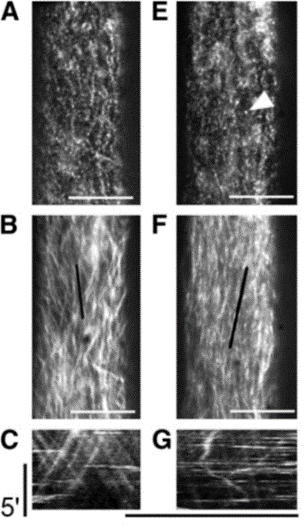Oligosaccharides profiling of different plant species.
We developed a strategy to study in planta the diversity of oligosaccharides from a wide range of plant species including Arabidopsis thaliana, tomato and wheat using size exclusion liquid chromatography coupled with high-resolution mass spectrometry method. We possess now a very broad oligoglycomic database (up to 1000 oligosaccharides).

The diversity of oligosaccharides is under-explored
Pectins are one of the major polysaccharides of the plant primary cell wall and they are composed of homogalacturonans that can be methylesterified and acetylesterified. The cleavage of the pectins generates oligosaccharides whose length (degree of polymerisation) and structure (degree of methylesterification and acetylation) vary and determine their elicitor activities. We recently showed that during the interaction between A. thaliana and Botrytis cinerea, 80 % of accumulated oligosaccharides were produced by fungal pectin lyase activities (Voxeur et al., 2019). We also showed that oligosaccharides from different origins are also produced; for example, some come from the degradation of xyloglucan suggesting that the diversity of oligosaccharides is under-explored (Voxeur et al., 2021).
Biological role of different secondary metabolites and herbicides
We are exploring the diversity of the metabolites and their biological function. To this aim, we are trying to purify them. We showed that semi-purified extracts enriched for a newly identified Gal4MeAc-H2O- activate plant defence in A. thaliana. We are also studying the role of fungal metabolites or herbicides on cell wall remodelling and cortical microtubule organisation. For instance, we study the impact of such molecules on the cellulose synthase complex by visualising the green fluorescent protein (GFP)-CESA3 fusion protein using spinning disk confocal microscopy in normal (A-C) or stressed conditions . In the figure, we can notice that the herbicide CGA promotes the internalisation of GFP-CESA3 into intracellular compartments (E-G). Some of these compartments are named MASC for microtubule-associated cellulose synthase compartment whose formation and movement depend on the dynamic cortical microtubule array (Crowell et al.,2009).

Imaging of plant growth in real time in the vertical position
We have recently developed a tool that we have named the VIP-box, allowing automated functional imaging of up to 15 whole, growing seedlings (A). The seedlings grow on a solid medium and vertically, then at each predefined time interval, the system switches, placing the seedlings horizontally and allows the acquisition of a sequence of images. The tool thus developed allows to link physiological processes quantifiable by fluorescence imaging (expression of a gene or a biosensor of pH(B), Ca2+, ROS, hormones...) to growth mechanisms along the seedling (apical or diffuse growth) (S. Vernhettes, F. Miart, DIRV_2018).

We developed a strategy to study in planta the diversity of oligosaccharides from a wide range of plant species including Arabidopsis thaliana, tomato and wheat using size exclusion liquid chromatography coupled with high-resolution mass spectrometry method. We possess now a very broad oligoglycomic database (up to 1000 oligosaccharides).

The diversity of oligosaccharides is under-explored
Pectins are one of the major polysaccharides of the plant primary cell wall and they are composed of homogalacturonans that can be methylesterified and acetylesterified. The cleavage of the pectins generates oligosaccharides whose length (degree of polymerisation) and structure (degree of methylesterification and acetylation) vary and determine their elicitor activities. We recently showed that during the interaction between A. thaliana and Botrytis cinerea, 80 % of accumulated oligosaccharides were produced by fungal pectin lyase activities (Voxeur et al., 2019). We also showed that oligosaccharides from different origins are also produced; for example, some come from the degradation of xyloglucan suggesting that the diversity of oligosaccharides is under-explored (Voxeur et al., 2021).
Biological role of different secondary metabolites and herbicides
We are exploring the diversity of the metabolites and their biological function. To this aim, we are trying to purify them. We showed that semi-purified extracts enriched for a newly identified Gal4MeAc-H2O- activate plant defence in A. thaliana. We are also studying the role of fungal metabolites or herbicides on cell wall remodelling and cortical microtubule organisation. For instance, we study the impact of such molecules on the cellulose synthase complex by visualising the green fluorescent protein (GFP)-CESA3 fusion protein using spinning disk confocal microscopy in normal (A-C) or stressed conditions . In the figure, we can notice that the herbicide CGA promotes the internalisation of GFP-CESA3 into intracellular compartments (E-G). Some of these compartments are named MASC for microtubule-associated cellulose synthase compartment whose formation and movement depend on the dynamic cortical microtubule array (Crowell et al.,2009).

Imaging of plant growth in real time in the vertical position
We have recently developed a tool that we have named the VIP-box, allowing automated functional imaging of up to 15 whole, growing seedlings (A). The seedlings grow on a solid medium and vertically, then at each predefined time interval, the system switches, placing the seedlings horizontally and allows the acquisition of a sequence of images. The tool thus developed allows to link physiological processes quantifiable by fluorescence imaging (expression of a gene or a biosensor of pH(B), Ca2+, ROS, hormones...) to growth mechanisms along the seedling (apical or diffuse growth) (S. Vernhettes, F. Miart, DIRV_2018).


Leader :
Samantha Vernhettes